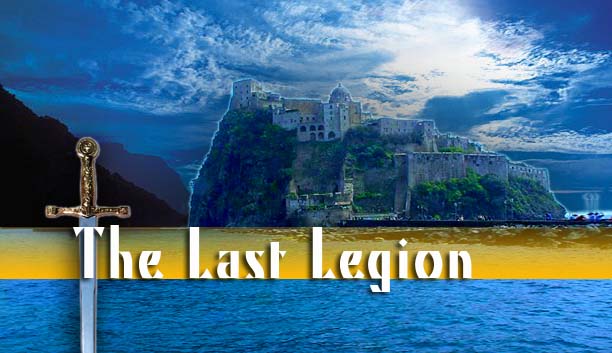

Rome, 476 AD. The Roman Empire is being threatened. A mighty force for almost 500 years, (at its height, Rome’s power spread from Mesopotamia in the east to the Iberian peninsula in the west, from the Rhine and Danube in the north to Egypt in the south), this story follows the gripping capture of young Romulus Augustus (THOMAS SANGSTER).
 On the
eve of twelve-year-old Romulus Augustus’ crowning ceremony to become
the new emperor, Barbarian general Odoacer (PETER MULLAN) arrives in
Rome to make a deal with Orestes (IAIN GLEN). Odoacer makes demands of
the Roman Empire in fair exchange for his decade-long support of the
Roman legions in the east. But Orestes refuses.
On the
eve of twelve-year-old Romulus Augustus’ crowning ceremony to become
the new emperor, Barbarian general Odoacer (PETER MULLAN) arrives in
Rome to make a deal with Orestes (IAIN GLEN). Odoacer makes demands of
the Roman Empire in fair exchange for his decade-long support of the
Roman legions in the east. But Orestes refuses.On Coronation day, as all of Rome gathers to watch the proceedings, Ambrosinus (SIR BEN KINGSLEY), the shaman who is a mentor and tutor to Romulus, predicts danger. Orestes is worried about his son’s safety and appoints Aurelius (COLIN FIRTH) of the fourth legion to be his personal guard. That night, Aurelius and his legionnaires confront danger—Odoacer and his army have returned to Rome.
With a deafening roar, the Barbarian army storms the city. A battle ensues, the brutal invaders show no mercy and blood flows through the streets. With Orestes slaughtered, Romulus is captured along with Ambrosinus and taken to the island fortress of Capri. There, Romulus finds the mythical sword of Caesar that holds the prophecy, “One edge to defend, one to defeat; …to fit the hand of he...who is destined to rule.”
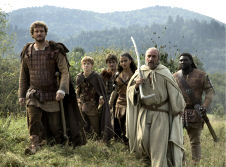 But, not all the Roman legionnaires are
dead. Aurelius is alive and when he learns that the Byzantine Empire
will give Romulus sanctuary, he embarks on a journey to the coast
accompanied by a small group of his men and a mysterious, black-clad
Byzantine warrior. Later, Aurelius discovers what lies behind the black
clothing—a beautiful, young woman named Mira (AISHWARYA RAI).
But, not all the Roman legionnaires are
dead. Aurelius is alive and when he learns that the Byzantine Empire
will give Romulus sanctuary, he embarks on a journey to the coast
accompanied by a small group of his men and a mysterious, black-clad
Byzantine warrior. Later, Aurelius discovers what lies behind the black
clothing—a beautiful, young woman named Mira (AISHWARYA RAI).Thanks to the strategic cunning of Ambrosinus and the fighting skill of Aurelius and Mira, Romulus is freed. But, when the group arrives on shore, they learn that the Byzantines have joined forces with Odoacer’s army of Goths. Faced with such betrayal, they must find the one legion still loyal to Rome—the ninth legion in Britannia.
As they set off in search of the last legion, Romulus and Aurelius together embark on a new beginning.
When principal photography began in Tunisia in August 2005, THE LAST LEGION finally became a reality. More than six years ago, Martha and Dino De Laurentiis started toying with the idea of making an action film based upon the fall of the Roman Empire. For the producers, the film had the makings of an epic adventure with the intimate story of a boy and his protectors at the heart.
"We based the idea on the book by Valerio Manfredi—The Last Legion—but combined that with historical facts and what was already known about the last Roman Emperor," says Martha De Laurentiis. "Nobody really knows what caused the fall of the Roman Empire and we decided to use that backdrop of chaos to tell the story of the last Emperor, a young boy, and his attempt to save the Empire. The fact that he was only 12 years old was at the root of the story."

The story follows the historically accurate fortunes of the 12-year-old Romulus Augustus, the last Roman Emperor who briefly rules the city before his parents are killed during the capture of Rome and he is banished to the fortress island of Capri. The story then speculates on what might have happened immediately thereafter. It follows the adventures of the soldiers still loyal to Caesar, who engineer his escape and then flee to distant Britannia, in search of the one legion still loyal to Rome.
Once the screenplay was completed, the next task was to find a director who could combine the contrasting elements of the story successfully.
Dino's daughter Raffaella De Laurentiis suggested Doug Lefler, as she had previously worked with him on DRAGONHEART 2. Both Raffaella and Martha thought he was the perfect choice: "Doug is an artist as well as a great action director. He could combine the epic scenes with the more intimate ones. He has a lot of experience working with the best action directors and his experience with animation gives him a clear idea how to tell a story. From the outset, he knew how he was visually going to tell this story, he storyboarded every single frame."
Doug Lefler explains how he became involved and what appealed to him about the project: "I was in a bookstore doing research on another project when I got a phone call from Raffaella De Laurentiis asking if I would read the script for a movie she and her father were working on. I read it that night and the next day I called her and said I would love to do it. This project is similar in a lot of ways to another film that she gave me about seven years ago, called DRAGONHEART 2, but bigger, grander and more complicated! The story is seen through the eyes of a 12-year-old child and that's the thing that was really fascinating to me. It's a very human, but also an epic story—an intimate epic. The film is very grounded in the characters, even though there are these huge events are going on around them. As a director, the most you can hope for in a project is that you get a compelling story and a good cast. I was lucky to get both."
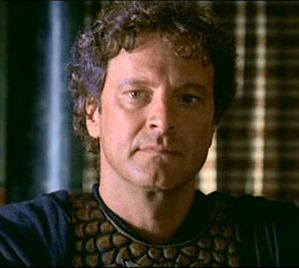 Finding the right actors for the central roles of
Aurelius, the leader of the band protecting Caesar, and Romulus, the
12-year old Emperor, was key. Harvey Weinstein was instrumental in
casting the central role. "Harvey loved this script and he immediately
suggested Colin Firth," explains Martha De Laurentiis. "So, we met
Colin who really liked the script and loves Italian culture. He was
very keen to try something different than the roles he is so well known
for. He is a powerful actor and this was a fantastic opportunity for
him to do something totally different."
Finding the right actors for the central roles of
Aurelius, the leader of the band protecting Caesar, and Romulus, the
12-year old Emperor, was key. Harvey Weinstein was instrumental in
casting the central role. "Harvey loved this script and he immediately
suggested Colin Firth," explains Martha De Laurentiis. "So, we met
Colin who really liked the script and loves Italian culture. He was
very keen to try something different than the roles he is so well known
for. He is a powerful actor and this was a fantastic opportunity for
him to do something totally different." The appeal for Colin Firth, best known for his performances as the brooding Mark Darcy in BBC’s PRIDE AND PREJUDICE and in the BRIDGET JONES films, was partly the chance to undertake a very different role, but also the attraction of the adventure story: "I've never been anywhere near this genre before. I haven't done anything with this much action and I didn't know what to expect. First and foremost, it was the story that attracted me; an adventure with a beginning middle and an end, in which you see the characters develop. There's also a bit of magic in it. It made me think of the way that I enjoyed stories when I was a child, which I think is storytelling in its purest form and, it gave me something of that. It felt different to any other thing I've done and I found that appealing. It involves a different set of skills that I've never really exercised."
Director Lefler didn't want to replicate how other action movies were cast: "We were looking for somebody that was a strong character, but I wanted the character of Aurelius to be more intelligent than he was brawny. So, we looked for an actor who could convey that sense of intelligence. We were very careful with casting. We wanted to do things that were unexpected, but right. In some ways, I was modeling the character of Aurelius after Horatio Hornblower. I wanted him to be more of a strategist than just somebody who was good with a sword. Colin has risen to that challenge wonderfully."
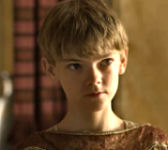 The
role of young Romulus went to Thomas Sangster, known for his roles in
LOVE ACTUALLY and NANNY McPHEE, both of which starred Firth. Sangster
was inspired to become an actor at a tender age after seeing his
parents, both actors by profession, performing. "I thought I'd give it
a go as it looked like fun," he says. "So, I had a couple of photos
done and sent them off to their agent and started getting auditions. I
got my first part and it just escalated from there."
The
role of young Romulus went to Thomas Sangster, known for his roles in
LOVE ACTUALLY and NANNY McPHEE, both of which starred Firth. Sangster
was inspired to become an actor at a tender age after seeing his
parents, both actors by profession, performing. "I thought I'd give it
a go as it looked like fun," he says. "So, I had a couple of photos
done and sent them off to their agent and started getting auditions. I
got my first part and it just escalated from there." About working with Firth for the third time, Sangster says: "I get to know him a bit better on each film we do. It's a relief coming onto a film where you already know someone, and somebody knows you and what you're like."
For the young actor, the film also had an educational element: "I had studied the Romans in school, but doing this film, I've learned a lot more about the Romans than I did when I was younger."
Director Lefler says of his young star: "Thomas turned out to be such a delight. He's great. What an incredibly talented young man!" Martha De Laurentiis adds: "Thomas was one of the last pieces of casting to fall into place. We were initially concerned with his size as he has to have the ability to fight and to carry a sword, but he had the physicality as well as the experience. We were very pleased to have him."
Colin Firth was delighted to be reunited with his young co-star and says that he was cast on his own merit: "It helped that I knew him already, but they had already clocked him for the role before I came on board. I kept my fingers crossed that he would be cast, and when they tested these boys, he won hands down. I wanted to work with him again because I knew that he's a terrific actor, but also because when you've worked with someone before, it gives you a shorthand. There's a trust, so you don't have to start from scratch."
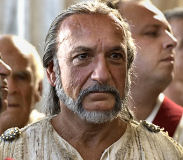 Sir Ben Kingsley, who plays the role of his teacher
Ambrosinus, adds: "He's a very contained, very private child. As an
actor, he has the capacity to dwell very much in his own world and I
think one of the lessons I'm learning from this role and from working
with young people—I recently did OLIVER TWIST with director Roman
Polanski where I worked with a lot of very young actors—is not to
interrupt them. If you see them digesting and exploring a private
moment, I tend to just sit with it. So, we have a very gentle, very
quiet, very respectful relationship both off and on the screen."
Sir Ben Kingsley, who plays the role of his teacher
Ambrosinus, adds: "He's a very contained, very private child. As an
actor, he has the capacity to dwell very much in his own world and I
think one of the lessons I'm learning from this role and from working
with young people—I recently did OLIVER TWIST with director Roman
Polanski where I worked with a lot of very young actors—is not to
interrupt them. If you see them digesting and exploring a private
moment, I tend to just sit with it. So, we have a very gentle, very
quiet, very respectful relationship both off and on the screen." Lefler knew he wanted to cast Academy Award-winner Kingsley after their first meeting: "We both had the same ideas for the character, we both saw him the same way—as a warrior shaman. Sir Ben's description of the character even matched some of the initial drawings I had done. I wanted him to be physically strong and able to fight, but in an unconventional way."
"Sir Ben was very serious in his preparation for the role and researched a lot of background material," Martha De Laurentiis adds. "He was interested in how the other characters affected his role and how he would affect them. He was great at helping Doug too, because he is so open about how he feels. He is really good in the role!"
Kingsley, found the part of Ambrosinus very appealing: "I love mythology, I love storytelling, I love shamanism, mystery, magic, healing powers, all these things really attract me and I found all these ingredients in the film and particularly in my character. I found the whole collection of men and women around this child very compelling and very moving. I responded to this role with my heart."
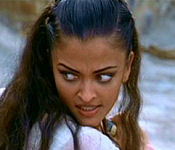 For
the role of the mysterious Byzantine warrior Mira, the filmmakers
turned to Bollywood star Aishwarya Rai. "In the casting of Mira, we
needed somebody that had a rare beauty, but we also needed somebody who
could move very well. I had watched some of Aishwarya's movies and I
know that she's trained as a dancer and that is good preparation for
doing martial arts and fighting," says Lefler. "Her character had to do
a lot of action scenes and we could take a lot of license with Mira’s
character. There was a very short list of people who could play this
part and Aishwarya was top of that list. We were privileged to get
her."
For
the role of the mysterious Byzantine warrior Mira, the filmmakers
turned to Bollywood star Aishwarya Rai. "In the casting of Mira, we
needed somebody that had a rare beauty, but we also needed somebody who
could move very well. I had watched some of Aishwarya's movies and I
know that she's trained as a dancer and that is good preparation for
doing martial arts and fighting," says Lefler. "Her character had to do
a lot of action scenes and we could take a lot of license with Mira’s
character. There was a very short list of people who could play this
part and Aishwarya was top of that list. We were privileged to get
her." Martha De Laurentiis adds: "Besides her beauty, she has such a charisma and warmth on screen. She has a really good chemistry with Colin Firth so you are emotionally involved in their relationship. As a dancer, she knows how to move, so she could be fast and elegant in the fight scenes. She was keen to take the role—to play the action hero - which was a challenge unlike any other part she has done."
Playing a more masculine role than she is used to appealed to Rai, best known for her performances in BRIDE & PREJUDICE and DEVDAS: "I've never done a character like Mira before and I like to give audiences something new with every film I do. I liked the idea of playing a warrior. We have reserves of strength and I guess the Mira in all of us comes out when provoked. She was a character I could identify with and I am sure other women will too."
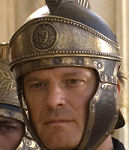
As with any period film, the costumes helped the actors get into character. Paolo Scalabrino, who has extensive experience on historical films, having worked on GANGS OF NEW YORK, TROY and the IMPERIUM television series, had to deal with the challenge of very limited source material. “There’s very little documentation on the period, but the one thing Doug Lefler was adamant about was that the costumes had to convey strength. Our main characters, Aurelius and the other legionnaires, spend most of the film traveling, so they are wearing lighter armor than usual. The look is very leathery, they’re not bulky, heavy costumes. This contrasts with what the legionnaires are wearing when they arrive in Rome at the beginning of the film for the coronation of Romulus Augustus—those costumes are much more official.”
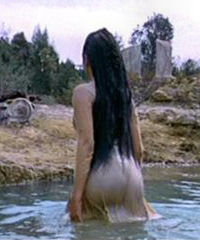
One of his biggest challenges was dressing Aishwarya Rai as Mira. “My first impression of Aishwarya in our initial meeting in London was of a very beautiful, feminine, delicate lady,” recalls the designer. “However, when she turned-up for work one month later she was toughened-up, well-toned and determined. She was a different person. She had put a lot of physical and mental energy into preparing for the role.”
“Doug wanted Mira to have an Asian edge so we gave her a Byzantine look,” continues Scalabrino. “For the story, she had to look very masculine at the beginning so we had to cover up her femininity. To achieve this, we used leather and metal to give her a harder, flatter silhouette. The problem was that she, like all the actors, had to be able to move around freely during the action sequences, so we sewed the harder materials onto a background of natural fabrics including wools, cottons, linens and silks—that’s what we used for all the costumes. We also used a lot of fake metals and leather painted on as metal. That allowed for flexibility.”
It was important for Lefler to have a seamless transition from dramatic scenes to action scenes. "I think it's a big mistake to think that action scenes are somehow radically different from other scenes," he explains. "There are a lot of films where the character development is one element of the story and the action is another. And I think that's a mistake. You find out who people are in action. When you have a desperate situation, you find out who's actually brave, who's actually responsible, who falls apart, who becomes the leader in an extreme situation. You don't want to stop the character development to have an action scene and then go back to character development. So, I think of action dramatically, the same way I would think of any other part of the script."
Firth adds: "It's not about digital battles and special effects with huge numbers of extras. I think a battle can only work if you are rooting for someone. You're only going to root for someone if you care about that person, so you have to have known them through the course of the story."
To this end, Lefler was keen that each character had his own fighting style. "Sir Ben as Ambrosinus fights with a staff in an unconventional way," he says. "Mira, is perhaps the best swordsman of the group. She tended to be all about grace and fluidity and speed. Rupert Friend plays Demetrius, who's the show-off—he's very flashy, he's young and brash. They all have their own styles and were all a reflection of who they are and what their place is in the story. Initially we thought that the main attribute of Nonzo Anozie, who plays Batiatus, would be strength, but when we started working with him we saw how light on his feet he was, so we played on that. We've tried to let the actors' own personalities come through in these characters."
Lefler took the slightly unusual step of drawing up storyboards for all of the action scenes before starting to work with the stunt and fight coordinators. "I gave them my ideas first which they then took to the next level. A lot of the sequences were designed very thoroughly before we got anybody else involved. Sword Master Richard Ryan and Steve Griffin our Stunt Coordinator, have done a great job of taking what I gave them and making them work in a practical way. When you sit down at your drawing board and you sketch up an idea, you don't always know if it's physically possible. It's always wonderful when you see something come to life and it actually works."
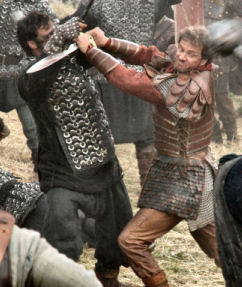 Sword Master Richard Ryan elaborates: "The
challenge was having four characters using essentially the same
weapons, but fighting distinctly from each other. We gave Vatrenus a
small shield that he fought with. For Aurelius, we wanted to show that
he was a tactical fighter and only fought if he had to. We gave
Byzantine warrior Mira an inverted grip of the sword, which was
consistent with the world she would have come from. While Demetrius,
who's a younger more impulsive character has two swords to give him a
slightly quicker style for the quicksilver character that he is."
Sword Master Richard Ryan elaborates: "The
challenge was having four characters using essentially the same
weapons, but fighting distinctly from each other. We gave Vatrenus a
small shield that he fought with. For Aurelius, we wanted to show that
he was a tactical fighter and only fought if he had to. We gave
Byzantine warrior Mira an inverted grip of the sword, which was
consistent with the world she would have come from. While Demetrius,
who's a younger more impulsive character has two swords to give him a
slightly quicker style for the quicksilver character that he is."A lot of work was put into training the actors to a high standard for the fight scenes so that the scenes look spontaneous and not choreographed. Stunt doubles were used to choreograph the fights and to teach them to the actors, but the actors learned the fights with gusto and performed them themselves. Says Ryan: "The preparation is important to get the performers to a level where they can fully commit to a fight with any necessary aggression that's needed, but have enough control that they're not really going to be hitting each other. They know how to cut the sword up or re-direct the energy so that they can play the fight."
To learn the method takes some training. About two months before filming began Colin Firth started learning the basics—how to hold the sword, how it worked for this particular period—and discussed his fighting style with Richard Ryan. Firth had previously learned to fight with swords at drama school and had also performed fights on stage: "It's a dance that you have to learn. What was new for me were these kinds of weapons. I had to unlearn the slightly more flowery eighteenth century stuff with the small swords and all the fancy footwork. These are big pieces of steel and I was a little worried about ever being able to move with it elegantly. I started early and worked with the fight director before filming started to acquaint me with the style and I came to love it. It's something I would almost take up. You use your body differently and in a more simple way."
Sir Ben Kingsley started training in his garden in Oxfordshire, on the croquet lawn, a couple of months before filming began to get used to using his stick: "It's basically like a silaylie, an Irish stick. It is a violent way of fighting where you use one fist as a fulcrum and you pull the stick around and by the time you hit your opponent, it's traveling at quite a speed with a hook on the end, so you can disarm them with it, you can snap wrists with it, you can cut their throats with it. It's really quite violent! I enjoy learning any new discipline and I particularly enjoyed learning this sort of martial art. We have very good teachers, so we all felt confident about what we were doing."
Firth adds: "I hope the fights are as exciting as some of the great fights that I remember seeing in the cinema. I remember caring about the outcome because you had become invested in the character and wanting revenge or success on behalf of the character for which you are rooting."
Lefler sums up his philosophy for the action scenes: "In some ways, we were aided in this project by not having a huge budget. I think when you have a huge budget, you often have a lot of toys and then you have a lot of extras and a lot of visual effects. When you don't have all of that to work with, you tend to naturally focus more on the characters, and what the characters are thinking becomes more important than the number of soldiers you have charging in the background. We also really wanted to avoid doing a film where we had a lot of CGI armies because we felt like that was something we've all seen a lot of. It doesn't mean anything now. It doesn't get anybody excited any more to see a thousand people running around behind your heroes with swords. We've seen too much of it. So we were very focused on the story, characters and the emotional point of each scene."
Filming took place over 14 weeks between August and November of 2005, with the shoot moving from Tunisia in North Africa, (standing in for Rome), to Slovakia in Eastern Europe (which doubled for Britannia).
Martha De Laurentiis explains: "Tunisia is not so far from southern Italy. It looks and feels the same. It's the same terrain, the same sea. Because Tunisia is also still rather unspoiled and not as built up as Italy, it is easier to film there. There is a fantastic studio there, Empire Studios, where they recreated Rome. They seem to have kept every building from every production ever made there. So that was a big plus, we didn't have to rebuild ancient Rome, it already existed there!"
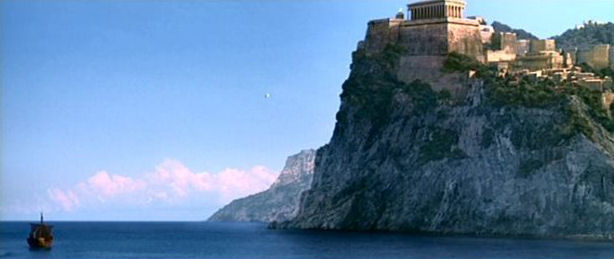
Tabarka, on the northern coast of Tunisia, and the crystal clear blue sea around it stood in for the Island of Capri, while Spisske Castle in Slovakia was used for the scenes in Britannia.
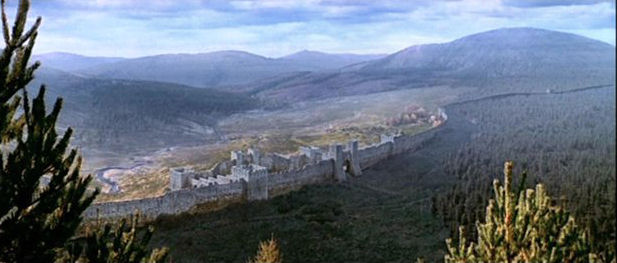
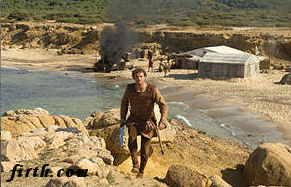 "We wanted Britannia to look
completely different from Rome. Tunisia and Slovakia are poles
apart," says Martha De Laurentiis. "The castle was so absolutely
perfect and the views from there are incredible—the landscape just goes
on for miles and miles, completely unspoiled."
"We wanted Britannia to look
completely different from Rome. Tunisia and Slovakia are poles
apart," says Martha De Laurentiis. "The castle was so absolutely
perfect and the views from there are incredible—the landscape just goes
on for miles and miles, completely unspoiled."For Firth the experience of making the film was very fulfilling: "I came into this not knowing if this was the sort of genre that I belonged in, and I now feel that I don't really want to do anything else. Of course, I'll be going off doing other things, but I just want to be on a horse waving a sword about now, traveling with a group of trusted friends. It's been the most wonderful experience."
Director Lefler says “In a lot of ways we are hoping that this film will appeal to everybody. We haven't aimed it at a family audience or an adult audience. There are mature elements and family friendly elements in this story. There are things that are family friendly in this story. It's got action, adventure and romance, and there's a child at the center of it. It's a story about loyalty and compassion and friendship. I'd like to think that these are universal elements—that everybody is going to find something in this film that's worth watching. It's got action and adventure. I'd want to go see this movie!”